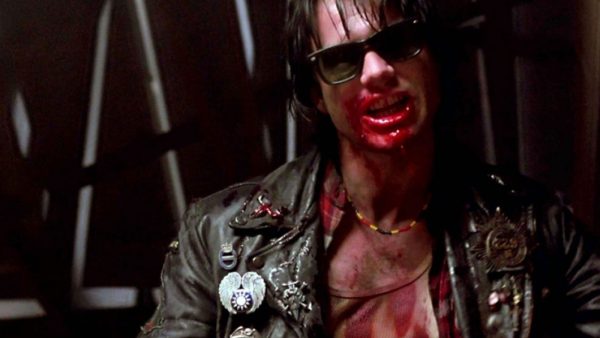Near Dark, 1987.
Directed by Kathryn Bigelow.
Starring Adrian Pasdar, Jenny Wright, Lance Henriksen, Bill Paxton, Jenette Goldstein and Tim Thomerson.
SYNOPSIS:
A farmer’s son, after an encounter with a mysterious drifter, finds himself reluctantly brought together with a pack of travelling vampires.
Upon its release in 1987, The Lost Boys was a huge commercial hit and near-instant cult classic that also acted as a touchstone in the cinematic depiction of vampires, moving the fanged monsters away from the castles and cape-wearing Counts of the past and into the modern day. Released a few months after The Lost Boys though was another film about modern-day vampires, although this would be a very different take that would take its time to find its following: Kathryn Bigelow’s neo-Western horror Near Dark.
When discussing Near Dark, it’s difficult to avoid comparisons to The Lost Boys, especially as they both have similar plots about a group of vampires bringing in a new member after a romantic entanglement. Where things differ however is in style, tone, and overall approach to the vampire lore.
The Lost Boys was a flashy, style over substance, 80s time capsule that portrayed vampires as hip and cool, making the prospect of living forever as a bloodsucker almost enticing. Near Dark, on the other hand, is a slower and darker affair that plays out like a modern-day Western and shows vampirism as a burden that prevents you from ever settling in one place, always hunting for blood and constantly looking for shelter from the dreaded sunlight. Living forever is no longer a blessing but a curse that stops you from growing old, as shown by the vampire Homer (Joshua John Miller), an apparently old man who loathes his lonely existence forever trapped in the body of a child.
I wasn’t kidding when I said this film is essentially an updated take on the classic Western. If you took away the fangs, Near Dark is an old-school story about a gang of outlaws, complete with six-shooters and spurs. The gang stalking through the dusty desert, looking to cause chaos in the various saloons and bars that litter the roads. There is even a gun battle with the law, albeit one that is made even more intense as the vampires attempt to fight while dodging the sunlight that leaks through the increasing number of bullet holes blasting through their shelter. The film’s merging of the Western and horror genres works beautifully, allowing the two to bounce off and service each other without one overpowering the other.
The western/horror story is complimented by the script that thankfully avoids detailed exposition about vampirism or explaining the “rules“. In fact, never once is the word “vampire” said throughout the entire film. Instead, Near Dark spends much of its time character-building through small exchanges that merely hint at the character’s backstories instead of bogging itself with massive exposition dumps of information. A simple line about the sinister Jesse’s (Lance Henriksen) past, in which he comments, “I fought for the South. We lost.” tells us all we need to know, showing roughly how long he’s been around and that he was no stranger to killing even before he grew the fangs.
The characters themselves are where the real meat of the film lies, with them brought to life by a great cast of cult character actors. Adrian Pasdar takes on the lead role of Caleb, the unwitting new recruit to a travelling posse of vampires. While Pasdar does a decent job with the role, he is perhaps the least interesting character, his role mainly serving as an audience surrogate. The real stars are, of course, the vampire gang led by the always-awesome Lance Henriksen. As the formidable and violent Jesse, Henriksen dominates the screen, the veteran character actor terrifying and intimidating with his scarred face, piercing eyes and growling voice.

While Henriksen is superb and terrifying, the film is stolen by the late Bill Paxton as Severin, a wise-cracking, grinning psychopath in spurs. Paxton is a joy to behold, playing the role with a barely hidden glee and a smarmy, vile sadistic charm that makes his every scene a nerve-jangling treat. Praise also should go to Jenette Goldstein, Jenny Wright and Joshua John Miller as Diamondback, Mae and Home, respectively, who, while not as memorable as their co-stars, still deliver compelling performances.
Near Dark is a slow burner, its careful, methodical pacing serving as the perfect complement to its more character-heavy story. The set pieces, while few and far between, are excellent throughout, featuring the various chases and gun battles one would expect from a Western. The stand-out is a violent bar room blood bath as the gang menace and murders the patrons, with the slow build-up to the inevitable blood-letting to being far more intense than the actual killing itself.
The story, while terrific, does have some minor issues. The third act, which introduces a deus ex machina of sorts in the form of a vampirism cure, is a rare misstep, with its sudden introduction almost feeling like an afterthought. And while the characters are richly drawn and well acted, the story itself is bare bones with little to no sense of urgency or purpose. The characters simply travel around and kill people while occasionally running into trouble with the law. While there are some story arcs, such as Caleb’s reluctance to kill despite his need for blood, they often fade into the background for long stretches – although I admit that these are minor issues, and while the pacing is slow and the story threadbare, the film is never boring.
A dark, violent and character-rich take on the vampire genre that is masterfully blended with its Western influences, Near Dark stands as a hugely fun and painfully underrated cult classic that acts as a perfect companion piece to that other 1987 vampire flick.
Flickering Myth Rating – Film: ★ ★ ★ ★ ★ / Movie: ★ ★ ★ ★
Graeme Robertson















